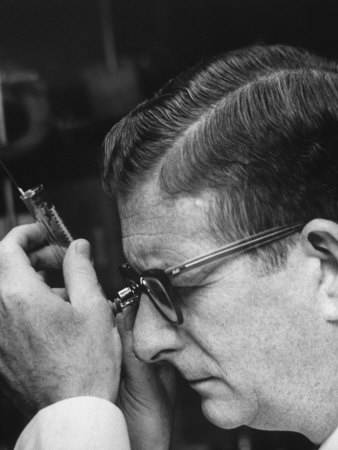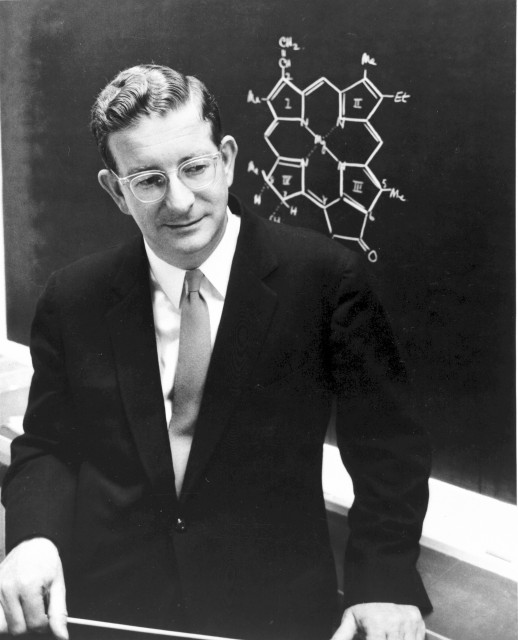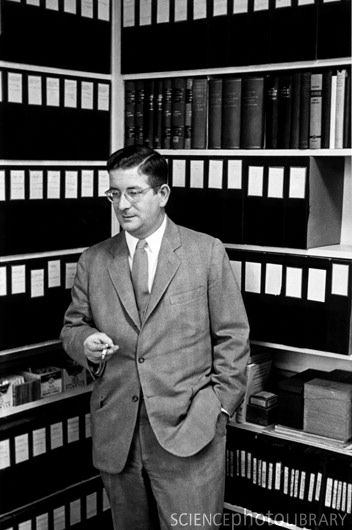<Back to Index>
- Chemist Robert Burns Woodward, 1917
- Composer Auguste Joseph Franchomme, 1808
- Marshal of France Jean Lannes, 1769
PAGE SPONSOR
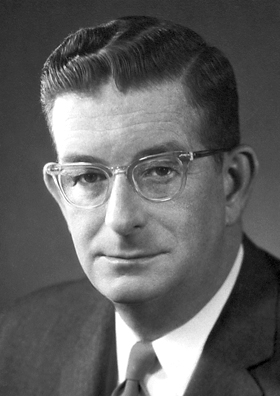
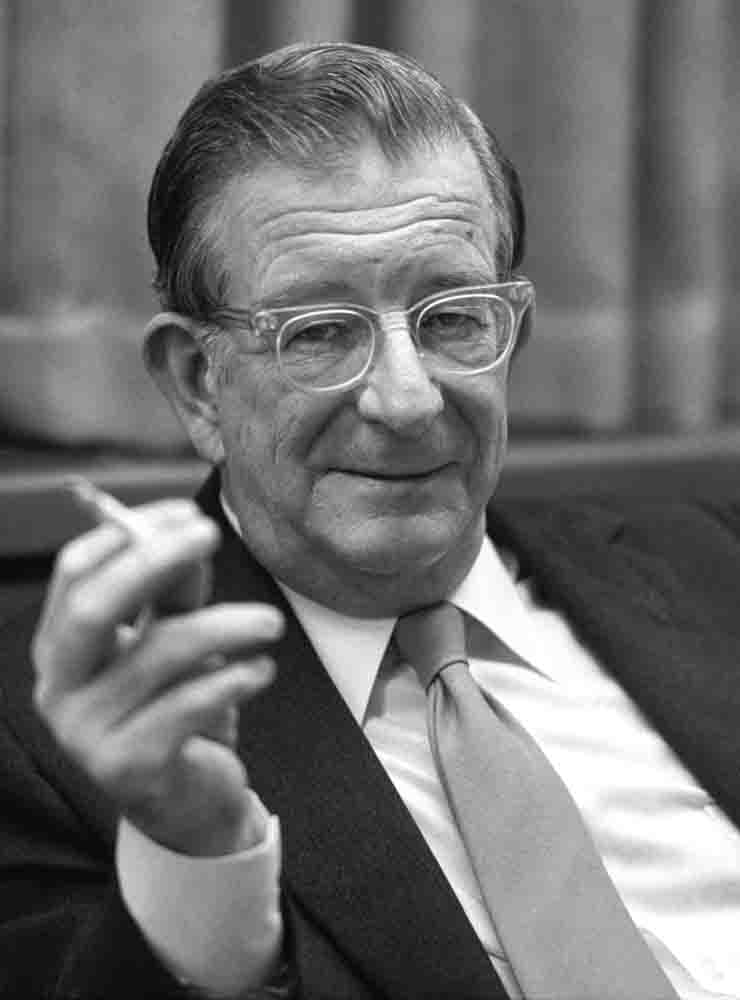
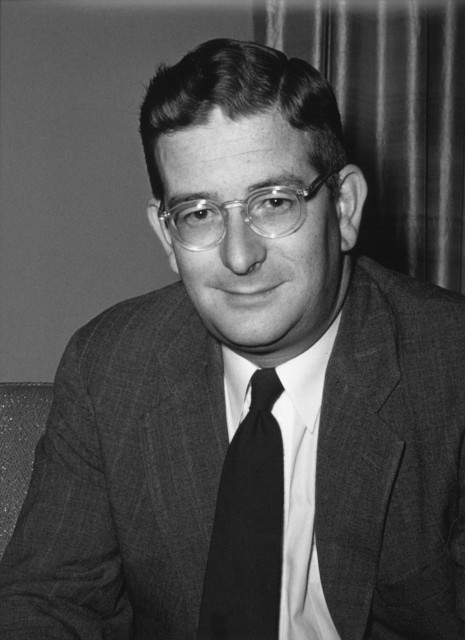
Robert Burns Woodward (April 10, 1917 – July 8, 1979) was an American organic chemist, considered by many to be the preeminent organic chemist of the twentieth century. He made many key contributions to modern organic chemistry, especially in the synthesis and structure determination of complex natural products, and worked closely with Roald Hoffmann on theoretical studies of chemical reactions. He was awarded the Nobel Prize in Chemistry in 1965.
Woodward was born in Boston, Massachusetts, to Margaret (née Burns, an immigrant from Scotland) and to Arthur Chester Woodward, son of Roxbury, Mass. apothecary, Harlow Elliot Woodward. When Robert was one year old, his father died in the flu pandemic of 1918.
From a very early age, Woodward was attracted to and engaged in private study of chemistry while he attended the public primary and secondary schools of Quincy, Massachusetts. By the time he entered high school, he had already managed to perform most of the experiments in Ludwig Gattermann's
then widely used textbook of experimental organic chemistry. In 1928,
Woodward contacted the Consul - General of the German consulate in
Boston, and through him, managed to obtain copies of a few original
papers published in German journals. Later, in his Cope lecture, he
recalled how he had been fascinated when, among these papers, he
chanced upon Diels and Alder's original communication about the Diels - Alder reaction.
Throughout his career, Woodward was to repeatedly and powerfully use
and investigate this reaction, both in theoretical and experimental
ways. In 1933, he entered the Massachusetts Institute of Technology (MIT),
but neglected his formal studies badly enough to be expelled the next
year. MIT readmitted him in 1935, and by 1936 he had received the Bachelor of Science degree. Only one year later, MIT awarded him the doctorate,
when his classmates were still graduating with their bachelor's
degrees. Woodward's doctoral work involved investigations related to
the synthesis of the female sex hormone estrone. MIT
required that graduate students have research advisors. Woodward's
advisor was Avery A. Ashdown, although it is not clear whether he
actually took any of his advice. After a short postdoctoral stint at
the University of Illinois, he took a Junior Fellowship at Harvard University from
1937 to 1938, and remained at Harvard in various capacities for the
rest of his life. In the 1960s, Woodward was named Donner Professor of
Science, a title that freed him from teaching formal courses so that he
could devote his entire time to research. The first major contribution of Woodward's career in the early 1940s was a series of papers describing the application of ultraviolet spectroscopy in
the elucidation of the structure of natural products. Woodward
collected together a large amount of empirical data, and then devised a
series of rules later called the Woodward's rules,
which could be applied to finding out the structures of new natural
substances, as well as non natural synthesized molecules. The expedient
use of newly developed instrumental techniques was a characteristic
Woodward exemplified throughout his career, and it marked a radical
change from the extremely tedious and long chemical methods of
structural elucidation that had been used until then. In 1944, with his post doctoral researcher, William von Eggers Doering, Woodward reported the synthesis of the alkaloid quinine, used to treat malaria.
Although the synthesis was publicized as a breakthrough in procuring
the hard to get medicinal compound from Japanese occupied southeast
Asia, in reality it was too long and tedious to adopt on a practical
scale. Nevertheless it was a landmark for chemical synthesis.
Woodward's particular insight in this synthesis was to realise that the
German chemist Paul Rabe had converted a precursor of quinine called
quinotoxine to quinine in 1905. Hence, a synthesis of quinotoxine
(which Woodward actually synthesized)) would establish a route to
synthesizing quinine. When Woodward accomplished this feat, organic
synthesis was still largely a matter of trial and error, and nobody
thought that such complex structures could actually be constructed.
Woodward showed that organic synthesis could be made into a rational
science, and that synthesis could be aided by well established
principles of reactivity and structure. This synthesis was the first
one in a series of exceedingly complicated and elegant syntheses that
he would undertake.
Culminating in the 1930s, the British chemists Christopher Ingold and Robert Robinson among
others had investigated the mechanisms of organic reactions, and had
come up with empirical rules which could predict reactivity of organic
molecules. Woodward was perhaps the first synthetic organic chemist who
used these ideas as a predictive framework in synthesis. Woodward's
style was the inspiration for the work of hundreds of successive
synthetic chemists who synthesized medicinally important and
structurally complex natural products. During the late 1940s, Woodward synthesized many complex natural products including quinine, cholesterol, cortisone, strychnine, lysergic acid, reserpine, chlorophyll, cephalosporin, and colchicine.
With these, Woodward opened up a new era of synthesis, sometimes called
the 'Woodwardian era' in which he showed that natural products could be
synthesized by careful applications of the principles of physical organic chemistry, and by meticulous planning. Many
of Woodward's syntheses were described as spectacular by his colleagues
and before he did them, it was thought by some that it would be
impossible to create these substances in the lab. Woodward's syntheses
were also described as having an element of art in them, and since
then, synthetic chemists have always looked for elegance as well as
utility in synthesis. His work also involved the exhaustive use of the
then newly developed techniques of infrared spectroscopy and later, nuclear magnetic resonance spectroscopy. Another important feature of Woodward's syntheses was their attention to stereochemistry or
the particular configuration of molecules in three dimensional space.
Most natural products of medicinal importance are effective, for
example as drugs, only when they possess a specific stereochemistry.
This creates the demand for 'stereospecific synthesis', producing a
compound with a defined stereochemistry. While today a typical
synthetic route routinely involves such a procedure, Woodward was a
pioneer in showing how, with exhaustive and rational planning, one
could conduct reactions that were stereospecific. Many of his syntheses
involved forcing a molecule into a certain configuration by installing
rigid structural elements in it, another tactic that has become
standard today. In this regard, especially his syntheses of reserpine and strychnine were landmarks. During World War II, Woodward was an advisor to the War Production Board on the penicillin project. Although often given credit for proposing the beta - lactam structure of penicillin, it was actually first proposed by chemists at Merck and Oxford and then investigated by other groups, as well (e.g., Shell). Woodward at first endorsed an incorrect tricyclic (thiazolidine fused, amino bridged oxazinone) structure put forth by the penicillin group at Peoria. Subsequently, he put his imprimatur on the beta - lactam structure, all of this in opposition to the thiazolidine - oxazolone structure proposed by Robert Robinson, the then leading organic chemist of his generation. Ultimately, the beta - lactam structure was shown to be correct by Dorothy Hodgkin using X-ray crystallography in 1945. Woodward also applied the technique of infrared spectroscopy and chemical degradation to determine the structures of complicated molecules. Notable among these structure determinations were santonic acid, strychnine, magnamycin and terramycin. About terramycin, Woodward's colleague and Nobel Laureate Derek Barton said: In
each one of these cases, Woodward again showed how rational facts and
chemical principles, combined with chemical intuition, could be used to
achieve the task. In the early 1950s, Woodward, along with the British chemist Geoffrey Wilkinson, then at Harvard, postulated a novel structure for ferrocene, a compound consisting of a combination of an organic molecule with iron. This marked the beginning of the field of transition metalorganometallic chemistry which grew into an industrially very significant field. Wilkinson won the Nobel Prize for this work in 1973, along with Ernst Otto Fischer. Some
historians think that Woodward should have shared this prize along with
Wilkinson. Remarkably, Woodward himself thought so, and voiced his
thoughts in a letter sent to the Nobel Committee. Woodward
won the Nobel Prize in 1965 for his synthesis of complex organic
molecules. In his Nobel lecture, he described the total synthesis of
the antibiotic cephalosporin, and claimed that he had pushed the synthesis schedule so that it would be completed around the time of the Nobel ceremony. In the early 1960s, Woodward began work on what was the most complex natural product synthesized to date - vitamin B12. In a remarkable collaboration with his colleague Albert Eschenmoser in
Zurich, a team of almost one hundred students and postdoctoral workers
worked for many years on the synthesis of this molecule. The work was
finally published in 1973, and it marked a landmark in the history of
organic chemistry. The synthesis included almost a hundred steps, and
involved the characteristic rigorous planning and analyses that had
always characterised Woodward's work. This work, more than any other,
convinced organic chemists that the synthesis of any complex substance
was possible, given enough time and planning. However, as of 2006, no
other total synthesis of Vitamin B12 has been published. That same year, based on observations that Woodward had made during the B12 synthesis, he and Roald Hoffmann devised rules (now called the Woodward - Hoffmann rules) for elucidating the stereochemistry of the products of organic reactions. Woodward formulated his ideas (which were based on the symmetry properties of molecular orbitals)
based on his experiences as a synthetic organic chemist; he asked
Hoffman to perform theoretical calculations to verify these ideas,
which were done using Hoffmann's Extended Hückel method. The predictions of these rules, called the "Woodward - Hoffmann rules" were verified by many experiments. Hoffmann shared the 1981 Nobel Prize for this work along with Kenichi Fukui,
a Japanese chemist who had done similar work using a different
approach; Woodward undoubtedly would have received a second Nobel Prize
as well had he lived. Note that a recent paper in the journal Nature describes how mechanical stress can be used to reshape chemical reaction pathways to lead to products that apparently violate Woodward – Hoffman rules.
While at Harvard, Woodward took on the directorship of the
Woodward Research Institute, based at
Basel, Switzerland, in 1963. He also became a trustee of his alma mater, MIT, from 1966 to 1971, and of the Weizmann Institute of Science in Israel. Woodward died in Cambridge, Massachusetts, from a heart attack in his sleep. At the time, he was working on the synthesis of an antibiotic, erythromycin. A student of his said about him: During
his lifetime Woodward authored or coauthored almost 200 publications,
of which 85 are full papers, the remainder comprising preliminary
communications, the text of lectures, and reviews. The pace of his
scientific activity soon outstripped his capacity to publish all
experimental details, and much of the work in which he participated was
not published until a few years after his death. Woodward trained more
than two hundred talented Ph.D. students and postdoctoral workers, many
of whom later went on to distinguished careers. Some of his best known students include Robert M. Williams (Colorado State), Harry Wasserman (Yale), Yoshito Kishi (Harvard), Stuart Schreiber (Harvard), William R. Roush (Scripps - Florida), Steven A. Benner (UF), Christopher S. Foote (UCLA), Kendall Houk (UCLA), porphyrin chemist Kevin M. Smith, and Ronald Breslow (Columbia University). Woodward had an encyclopaedic knowledge of chemistry, and an extraordinary memory for detail. Probably
the quality that most set him apart from his peers was his remarkable
ability to tie together disparate threads of knowledge from the
chemical literature and bring them to bear on a chemical problem.
His
lectures were legendary and frequently used to last for three or four
hours. [His longest known lecture defined the unit of time known as the
"Woodward", and thereafter his other lectures were deemed to be so many
"milli - Woodwards" long!] In many of these, he eschewed the use of
slides and used to draw beautiful structures by using multicolored
chalk. As a result, it was always easy to take good notes at a Woodward
lecture. Typically, to begin a lecture, Woodward would arrive and lay
out two large white handkerchiefs on the countertop. Upon one would be
four or five colors of chalk (new pieces), neatly sorted by color, in a
long row. Upon the other handkerchief would be placed an equally
impressive row of cigarettes. The previous cigarette would be used to
light the next one. His famous Thursday seminars at Harvard often
lasted well into the night. He had a fixation with blue, and all his
suits, his car, and even his parking space were coloured in blue. In
one of his laboratories, his students hung a large black and white
photograph of the master from the ceiling, complete with a large blue
"tie" appended. There it hung for some years (early 1970s), until
scorched in a minor laboratory fire. He detested exercise, could get
along with only a few hours of sleep every night, was a heavy smoker, and enjoyed Scotch whiskey and a martini or two.
For
his work, Woodward received many awards, honors and honorary
doctorates, including election to the National Academy of Sciences in
1953, and membership in academies around the world. He was also a
consultant to many companies such as Polaroid, Pfizer, and Merck. Other awards include:
In 1938 he married Irja Pullman; they had two daughters. In 1946, he married Eudoxia Muller, an artist and technician whom he met at the Polaroid Corp. This marriage, which lasted until his death in 1979, produced a daughter and a son.
